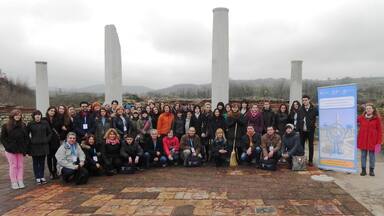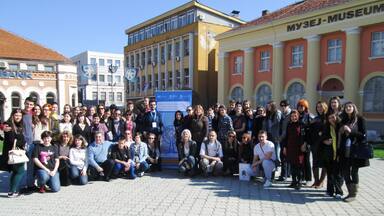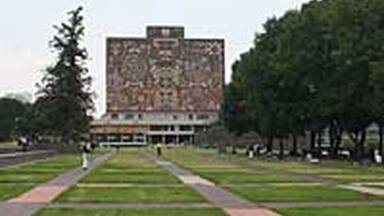Gamzigrad-Romuliana, Palace of Galerius
Gamzigrad-Romuliana, Palace of Galerius
The Late Roman fortified palace compound and memorial complex of Gamzigrad-Romuliana, Palace of Galerius, in the east of Serbia, was commissioned by Emperor Caius Valerius Galerius Maximianus, in the late 3rd and early 4th centuries. It was known as Felix Romuliana, named after the emperor’s mother. The site consists of fortifications, the palace in the north-western part of the complex, basilicas, temples, hot baths, memorial complex, and a tetrapylon. The group of buildings is also unique in its intertwining of ceremonial and memorial functions.
Description is available under license CC-BY-SA IGO 3.0
Gamzigrad-Romuliana, palais de Galère
Gamzigrad, à l’est de la Serbie, est un palais fortifié de l’époque romaine tardive, associé à un mémorial sur la colline adjacente. Il fut édifié à la fin du IIIe siècle et au début du IVe siècle, sur ordre de l’empereur Caius Valerius Galerius Maximianus et est connu sous le nom de Felix Romuliana, du nom de la mère de l’empereur. Le site est constitué de fortifications, d’un palais dans la partie nord-ouest de l’ensemble, de basiliques, temples, thermes, mémorial et d’un tétrapyle. Le groupe de constructions est aussi unique en ce qu’il entremêle cérémonial et mémorial.
Description is available under license CC-BY-SA IGO 3.0
غامزيغراد- روموليانا، قصر غاليريوس
غامزيغراد قصر روماني محصَّن وقديم يقابله مجمَّع تذكاري على هضبة مجاورة. بني القصر في أواخر القرن الثالث ومطلع القرن الرابع بتفويض من الامبراطور الروماني كايوس فاليريوس غاليريوس ماكسيميانوس، وكان يُدعى قصر "فيليكس روموليانا"، نسبةً إلى والدة الامبراطور. ويحوي الموقع تحصينات عدة، فيما القصر الواقع في شمال غرب المجمَّع يؤوي معابد وحمامات ساخنة ومجمَّعاً تذكارياً وبوابات ضخمة. كما يوفر الموقع شهادة فريدة عن تقاليد البناء الرومانية، ويزاوج بين الوظائف الاحتفالية والتذكارية.
source: UNESCO/CPE
Description is available under license CC-BY-SA IGO 3.0
贾姆济格勒-罗慕利亚纳的加莱里乌斯宫
贾姆济格勒-罗慕利亚纳的加莱里乌斯宫位于塞尔维亚东部,建于3世纪末至4世纪初的罗马帝国末期,是皇帝加莱里乌斯下令修建的。这座堡垒式宫殿以皇太后菲利克斯•罗慕利亚纳的名字命名,包括城堡、位于建筑群西北部的宫殿、教堂、修道院、浴室、礼拜堂和一座凯旋门。这处遗产是罗马传统建筑的典型代表,同时带有第二次四君主制时期的思想烙印。这处建筑群的独特之处,还在于将举行仪式和纪念活动的功能集于一身。整个建筑群分为两大部分,中间以凯旋门相连。巨大的拱门横跨道路,一侧是堡垒和宫殿。另一侧是墓地和纪念碑。
source: UNESCO/CPE
Description is available under license CC-BY-SA IGO 3.0
Дворец Галерия «Гамзиград-Ромулиана»
Архитектурный ансамбль, включающий замок позднего периода Римской империи и мемориал, был внесен в Список как образец традиционной архитектуры Римской империи периода второй тетрархии. Сочетание церемониальных элементов с чертами мемориала составляют еще одну отличительную особенность этого ансамбля. Пространственная связь между двумя архитектурными группами объекта устанавливается с помощью тетрапилона, расположенного на перекрестке между дворцом с его фортификациями – символами мирского - с одной стороны, и мавзолеями и мемориальными сооружениями – символами духовного – с другой.
source: UNESCO/CPE
Description is available under license CC-BY-SA IGO 3.0
Gamzigrado-Romuliana – Palacio de Galerio
Situado al este de Serbia, el sitio de Gamzigrado es un complejo monumental de la época romana tardía formado por una serie de edificios palatinos fortificados y un conjunto construcciones conmemorativas situado en una colina adyacente. Su construcción, ordenada por el emperador romano Cayo Valerio Galerio Maximiano, data de finales del siglo III y principios del siglo IV. El sitio, designado con el nombre de la madre del emperador, Felix Romuliana, comprende, además del palacio situado en la parte noroccidental, una serie de fortificaciones, basílicas, templos, termas y edificios conmemorativos, así como un tetrapylon. Este vasto complejo monumental es un ejemplo único en su género del entrelazamiento de las funciones ceremoniales y conmemorativas.
source: UNESCO/CPE
Description is available under license CC-BY-SA IGO 3.0
ガムジグラード‐ロムリアーナ、ガレリウスの宮殿
source: NFUAJ
Gamzigrad-Romuliana, paleis van Galerius
Source: unesco.nl
Outstanding Universal Value
Gamzigrad-Romuliana is a Late Roman palace and memorial complex built in the late 3rd and early 4th centuries, commissioned by the Emperor Galerius Maximianus. The strong fortifications of the palace are an allusion to the fact that the Tetrarchy Emperors were all senior military leaders. The spatial and visual relationships between the palace and the memorial complex, where the mausoleums of the Emperor and his mother Romula are located, are unique.
Criterion (iii): The fortifications, the palace, and the memorial complex are a unique testimony of the Roman construction tradition pervaded by the ideological programme of the Second Tetrachy and Galerius himself as their builder.
Criterion (iv): The group of buildings comprising the architectural complex of the Emperor Galerius is unique in that it intertwines the ceremonial and the memorial programme. The relation between two spatial ensembles is stressed by placing the Tetrapylon on the crossroads between the worldly fortification with the palace and the other-worldly mausoleums and consecration monuments.
The integrity and authenticity of Gamzigrad-Romuliana are clearly demonstrated: relatively few excavations have been carried out to date and there has been no attempt to reconstruct the much degraded remains. There are no plans for reconstruction beyond what is needed for conservation and can be substantiated through research, as these would diminish the level of authenticity.
The property is protected by: the Decision by the Institute for the Preservation and Scientific Examination of the Cultural Goods of the PR of Serbia (No 407/48, 19 March 1948); the Decision on the Identification of Immovable Cultural Goods of Outstanding and of Great Importance (Official Gazette 14/79); the Cultural Properties Law (The Official Gazette of the Republic of Serbia, No 71/94). A buffer zone has been established. The conservation of the remains is satisfactory. The property is managed at the level of the Republic of Serbia by the Institute for the Protection of Cultural Monuments of Serbia.



